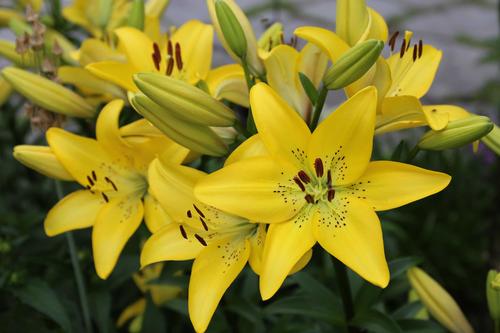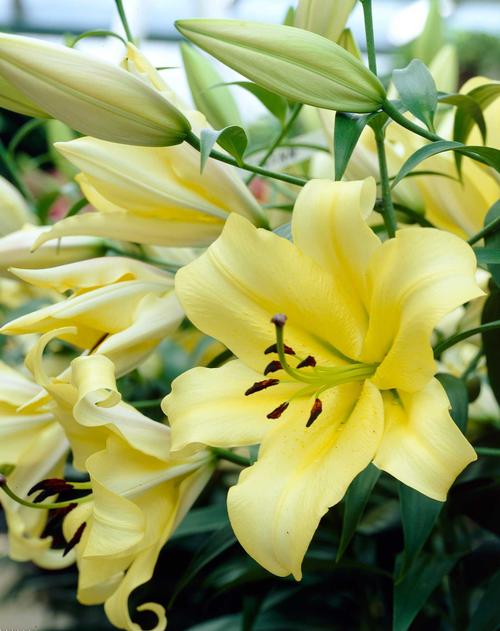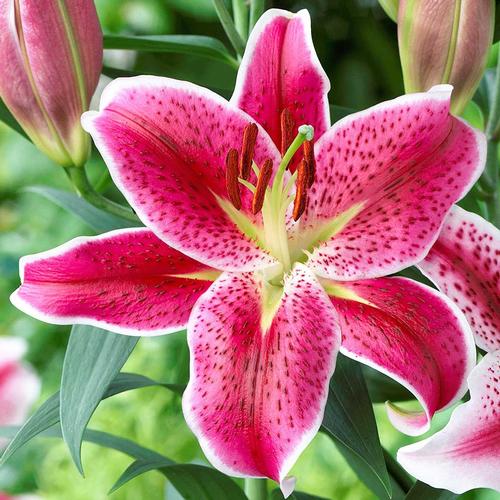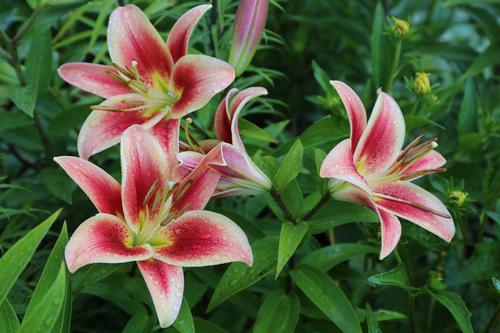Types of Lilies and How to Use Them in Your Garden
Lilies bloom at the height of summer and produce some of the garden’s most impressive flowers. Here’s what you’ll need to know about choosing, planting and caring for these beautiful summer-blooming perennials.
Unlike daylilies, true lilies grow from bulbs that can be planted in either spring or fall. The plants have thick, upright stems and large, trumpet-shaped flowers. Many gardeners don't realize that there are several different types of true lilies. They look quite different from each other and they bloom at different times during the summer. Here’s how to tell them apart.
Types of Lilies
Asiatic lilies are the first lilies of the season and usually start flowering in June, right after the peonies. Asiatics are also the shortest type of lily, typically standing about 2 to 3 feet tall. Their upward-facing flowers come in many different colors, from white through yellow, orange, pink, red and deep burgundy. Asiatic lilies do not have a fragrance, but their flowers add bold, bright color to early summer gardens. These lilies also grow well in containers and make great cut flowers. Shown at left is 'Lollypop'.

Asiatic-Oriental lilies are relatively recent hybrids that combine the brilliant colors of Asiatic lilies with the larger flowers and taller stature of an Oriental lily. They were developed for the cut flower industry, but in addition to being great for bouquets, they are also excellent garden plants. AO lilies are 3 to 4 feet tall, which is a perfect height for perennial gardens. They also grow very well in containers. Shown at left is 'Kaveri'.

Trumpet lilies begin blooming in midsummer. The flowers have long, narrow trumpets and come in white, cream, yellow, peach and pink. Trumpet lilies tower over other perennials, often reaching a height of 4 to 6 feet. Their flowers are deeply fragrant, and just a few plants will perfume your entire garden – especially in the evening. Shown at left is 'Golden Splendor'.

Longiflorum-Asiatic lilies are hybrid crosses between longiflorum lilies, which are the fragrant white lilies best known as Easter lilies, and Asiatic lilies. The flowers have thick, smooth petals and clear, bright colors. Most stand about 4 feet tall and have a light fragrance. Longiflorum lilies grow well warm climates, so LA hybrids are a good choice for southern gardens (though they're also hardy to zone 4). Shown at left is 'Yellow Diamond'.

Oriental-Trumpet Lilies, sometimes called OT lilies or Orienpets, are a cross between Trumpet Lilies and Oriental Lilies. They bloom in mid to late summer and display all the best qualities of both parents. The blossoms are large with thick petals and come in both single colors and bi-colors. The flower shape is relatively open and they may face up, out or downward on the stem. Orienpets are very winter hardy and they usually bloom about 2 weeks before Oriental lilies. They are 4 to 6 feet tall and all are very fragrant. Shown at left is 'Yelloween'.

Oriental Lilies bloom from mid to late summer. They have large, outward-facing flowers that open wide and are more flat than trumpet-like. The pink and white lily known as ‘Stargazer’ is a type of Oriental lily. Flower colors for Oriental lilies range from yellow and white through pink and burgundy, with many displaying contrasting freckles or stripes on their petals. Double varieties are also available. Oriental lilies are ideal for perennial gardens and they also grow very well in containers. Heights range from 3 to 4 feet tall. As cut flowers, their lovely fragrance will fill an entire room. The lily at left is 'Colorado'.

Species Lilies have smaller, more delicate flowers. The blossoms are typically downward-facing and the petals are usually pulled back from the stamens. Tiger lilies are a type of species lily, as are martagon and Canada lilies. Though their flowers are not as large as other lilies, they have their own charm and are an excellent choice for natural areas or woodlands as they will tolerate partial shade and moist soil. Heights are variable -- from 2-foot martagons to 5 foot 'Black Beauty'. Most have little to no fragrance. Shown at left is 'Lady Alice'.

How to Care for Lilies
With such big, exotic flowers, it seems like lilies would be fussy plants, but they’re not. They grow well in full sun to light shade and are not particular about soil, as long as it doesn’t get soggy. The bulbs can be planted in early spring or late fall, and are hardy in zones 4 to 9.
Lilies look best when you plant the bulbs in groups of 3 or more. Dig a generous planting hole 8” deep. Put about 1/8 cup of all-purpose granular fertilizer in the bottom of the hole and mix it around to disperse. Add a few handfuls of loose soil back into the hole and then position the bulbs so they’re 6 to 7 inches deep (follow instructions on the packaging).

Like other bulbs, lilies are very easy to grow. Plant them in well drained soil, fertilize them once a year, and avoid crowding the plants. If red lily leaf beetles are a problem in your area, start looking for them in the spring as soon as the plants emerge. Kill any beetles that you find and do the same with their larvae (learn more here). Deer and rabbits love eating lilies, so if these animals are a problem in your area, protect your lilies by spraying them weekly with a scent deterrent. Click HERE to learn more about protecting gardens from deer.
As the flowers on your lily plants fade, you can use scissors to remove them, leaving the central stem behind. A lily’s foliage grows directly on the stem, and like other bulbs, the plants need their foliage to produce the energy for next year’s flowers. The stems can be cut to the ground in the fall, once they are completely yellow. If you are growing lilies for cut flowers, you may want to start with fresh bulbs each year.


